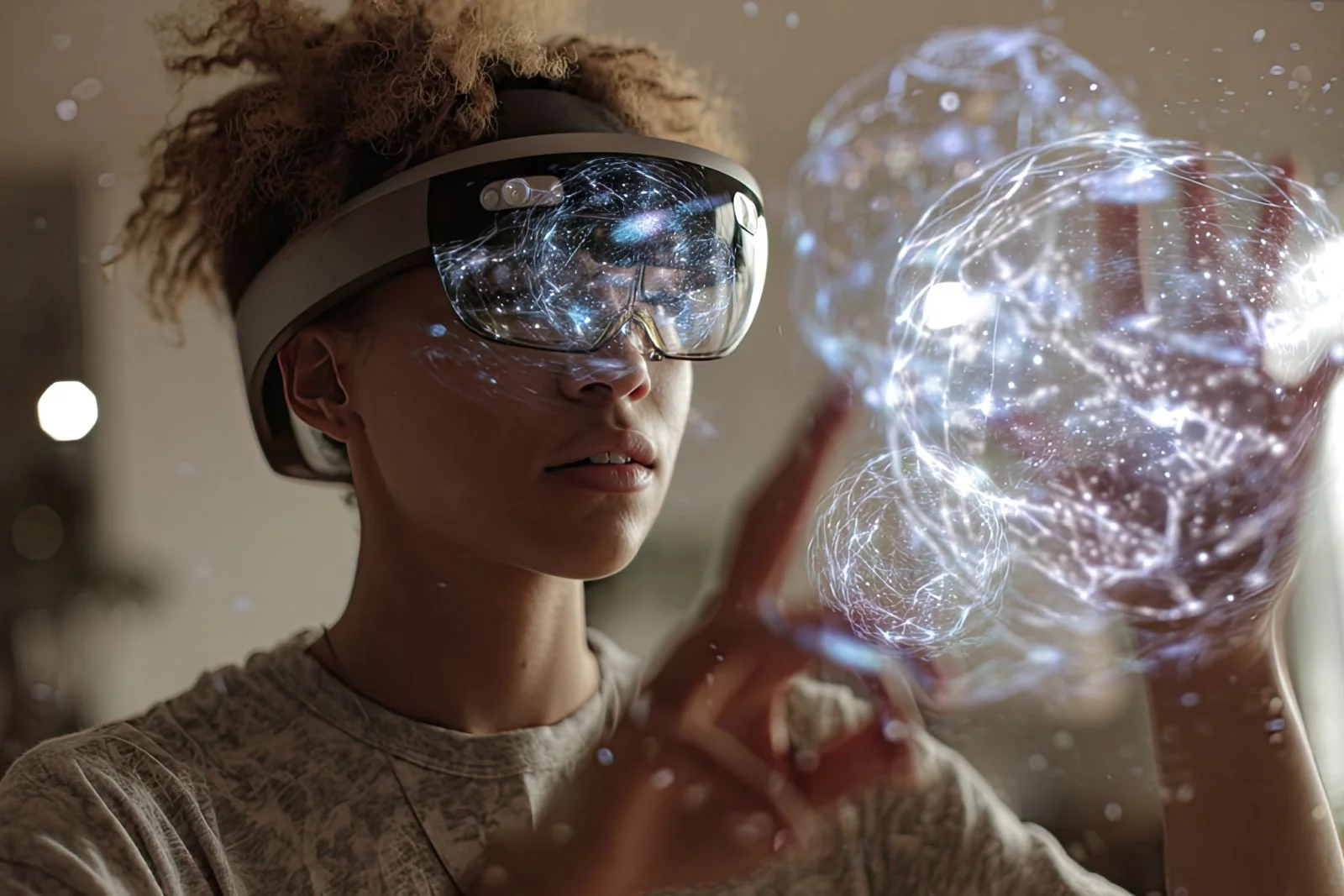Across the tech industry, tech giants envision a future beyond smartphones, unveiling ambitious strategies that move beyond traditional handheld devices. Companies are shifting focus toward innovations like spatial computing, brain-computer interfaces, and context-aware AI systems.
As tech leaders envision a post-smartphone future, the central question becomes: what will replace the smartphone? They’re also considering what will replace cell phones, not by eliminating mobile connectivity, but by transforming how we interact with technology in everyday life.
The Shift to a Post-Smartphone Era
Smartphone Market Saturation
Over the past decade, the smartphone market has matured. Annual upgrades yield diminishing novelty. Many markets are saturated; many consumers hold on to devices longer. According to industry analysis, global smartphone shipments plateaued, and innovations like slightly better cameras or faster chips no longer excite users.
Incremental gains can’t sustain growth forever. So the major players are pivoting toward entirely new paradigms, questioning what will replace smartphones in the years ahead.
Changing User Expectations
Users today expect more — more context-awareness, more seamless integration, less friction. The idea of pulling out a glass slab from pocket for every interaction feels archaic to many innovators.
There’s a desire for hands-free, ambient, privacy-respecting interfaces. In surveys, a majority of respondents say they’d adopt devices that anticipate their needs without constant manual input.
Thus, tech giants envision the post-smartphone future not as a sci-fi dream, but as a next step in evolving how we relate to machines.

The Push Toward Immersive Technologies
Meta’s Vision: AR, AI, and the Metaverse
Meta has long been vocal about a future beyond phones. Mark Zuckerberg has stated that AR glasses could replace smartphones in a decade.
Their “Orion” smart glasses aim to embed AI and holography in eyewear, enabling hands-free calls, navigation, and overlaying digital info on the world around you.
Meta’s strategy is to merge AR, AI, and the metaverse — making the physical and virtual realms more seamless.
Neuralink: Brain-to-Digital Interfaces
Elon Musk’s Neuralink is arguably the boldest bet. Instead of relying on external hardware, it aims to connect brains directly to computers via implanted electrodes. This could effectively eliminate the need for screens or physical input.
Neuralink sees a future where thought controls devices, bypassing speech, touch, or gestures.
OpenAI: Embedding AI into Everyday Life
OpenAI envisions “ambient intelligence” — AI woven into our environments, aware of context and ready to assist proactively. Rather than launching a single product, their vision is pervasive: offices, homes, streets, and bodies become intelligent in themselves.
Their model is that devices fade, but intelligence remains always present.
Google: AI-Driven AR Ecosystem
Google is not silent. Their Android XR initiatives and Project Astra aim to push AR forward on an open, extensible platform.
Google’s Gemini AI can shift across devices — glasses, earbuds, ambient sensors — reducing the need for a central “phone.”
Apple: Spatial Computing and Vision Pro
Apple’s approach is more cautious but no less ambitious. They are gradually deconstructing the iPhone’s functions into wearables like Apple Watch, AirPods, and the Vision Pro headset.
Their aim isn’t to abandon mobile phones immediately but to reimagine them as part of a larger, spatial ecosystem. The iPhone becomes one node among many, with spatial computing as the interface.
Microsoft: Mixed Reality and HoloLens
Microsoft, long in enterprise, pushes mixed reality through HoloLens. Its goal is holographic overlays, gesture interaction, and AI-powered visual assistants built into workspaces.
They lean toward augmented rather than replacement — augmenting workflows, not erasing devices overnight. Read another article on Technology trends
Breakthrough Technologies Powering the Transition
Next-Gen Display and Visual Systems
To displace screens, we need new ways to project visuals — waveguides, retinal projections, holography. Meta’s partnerships in waveguide optics aim for retina-level clarity while remaining transparent.
Microsoft is experimenting with mid-air holographic projections — visuals that hover without any device touching your face.
Mojo Vision’s smart contact lens research, though nascent, hints at a future where your eye becomes the display.
Cloud + Edge Computing Integration
A shift away from local, monolithic hardware demands robust computation elsewhere. Hybrid models—blending on-device AI, edge processing, and cloud backends—are key.
Devices will rely on offloading heavy tasks but retain autonomy when needed.
Battery Life and Power Efficiency Innovations
The critical practical hurdle is power. New display systems, AI loads, and sensors demand highly efficient energy solutions.
Wireless charging, proximity energy transfer, or even ambient harvesting (solar, kinetic) are being explored to support wearables and implants.
What Comes After the Smartphone?
AI Companion Devices
Instead of a single device, you might carry or wear an AI companion—something that listens, thinks, and acts. These devices won’t replace smartphones in name, but in function.
Smart Glasses and Visual Interfaces
Smart glasses are the front-runner answer to what will replace mobile phones. They overlay information, take calls, read text, and act as navigation assistants without needing to pull out a phone.
Brain-Computer Interfaces
BCIs could leapfrog external hardware altogether. With implants or non-invasive neural sensors, interaction may become purely cognitive — what will replace smartphones is your mind.
Wearables as Primary Interfaces
The smartwatch, earbuds, rings, or smart clothing become more than accessories — they become primary interfaces. Over time, many smartphone functions will migrate to these form factors.
The Ambient Computer Era
Invisible, Context-Aware Computing
In this vision, computation recedes into the background. You don’t “open” an app — your environment senses your needs and surfaces what matters. This is the ambition behind ambient computing.
Technology Embedded in Everyday Life
Walls, clothes, furniture, windows — all become interfaces. Sensors and intelligent surfaces turn everyday objects into responsive digital conduits.
In such a world, what will replace the smartphone is not a device, but a pervasive intelligent layer.
Challenges and Consumer Insights
Privacy and Data Security
More sensors, deeper integration, brain interfaces — this raises existential questions: who holds your thoughts, intentions, data? Security must be ironclad, transparent, and auditable.
Social Acceptance of New Interfaces
Glasses on the face, implants in the brain — adoption depends as much on comfort and social norms as on technical performance. Many people may resist until devices look, feel, and operate naturally.
Power Management and Device Longevity
Even with breakthroughs, battery life and durability are hurdles. Wearables must last through daily use, implants must last years.
Ecosystems in Battle
Open vs Closed Platform Strategies
Apple prefers tight integration and control; Google champions openness; Meta plays in between. Each approach has tradeoffs: user convenience vs developer freedom.
Cross-Platform Compatibility and Lock-in Risks
If each giant pushes its own standard for next hardware, fragmentation may hurt consumers. Bridging compatibility will be crucial to avoid repeat “format wars.”
Final Thoughts
As we move into a new era of digital interaction, it’s clear that tech giants envision a future beyond smartphones as more than just a hardware upgrade—it’s a shift in how we live, work, and connect.
From AI companions and smart glasses to brain-computer interfaces and ambient computing, the next phase of technology is designed to be more intuitive, immersive, and integrated into our daily lives.
While challenges like privacy, power efficiency, and social acceptance remain, the momentum toward a post-smartphone world is undeniable. The companies shaping this future aren’t merely replacing the smartphone—they’re redefining what personal technology can be.
Whether through wearables, spatial computing, or invisible AI systems, one thing is certain: the future of human-computer interaction is being rewritten before our eyes. And the device of tomorrow might not be a device at all.
FAQs
What could replace smartphones in the future?
AI Summary: Wearable tech like AR/MR smart glasses may take over, enabling immersive, hands-free interaction powered by AI, making phones a secondary processor.
What lies ahead for mobile devices?
AI Summary: Phones will evolve with AI-driven personalization, flexible designs, and shift toward ambient computing via wearables and neural tech.
How might mobile tech look in 50 years?
AI Summary: By 2074, communication tools may blend into clothing or the body, becoming invisible yet essential parts of human experience.
Which smartphone is currently the most cutting-edge?
AI Summary: Top 2025 models include Galaxy S25 Ultra, iPhone 17 Pro Max, and Pixel 10 Pro, each excelling in AI, performance, and camera tech.
Who is the proprietor of Android OS?
AI Summary: Google owns Android after acquiring it in 2005, overseeing its development and key proprietary elements like Play Services.













